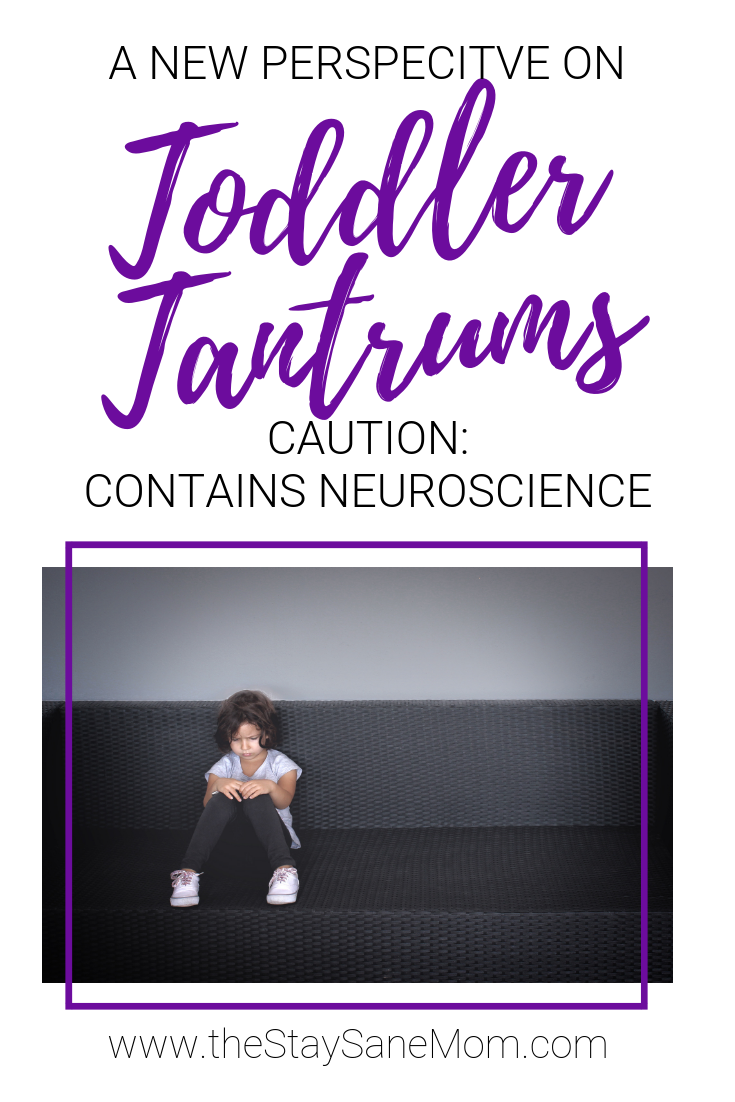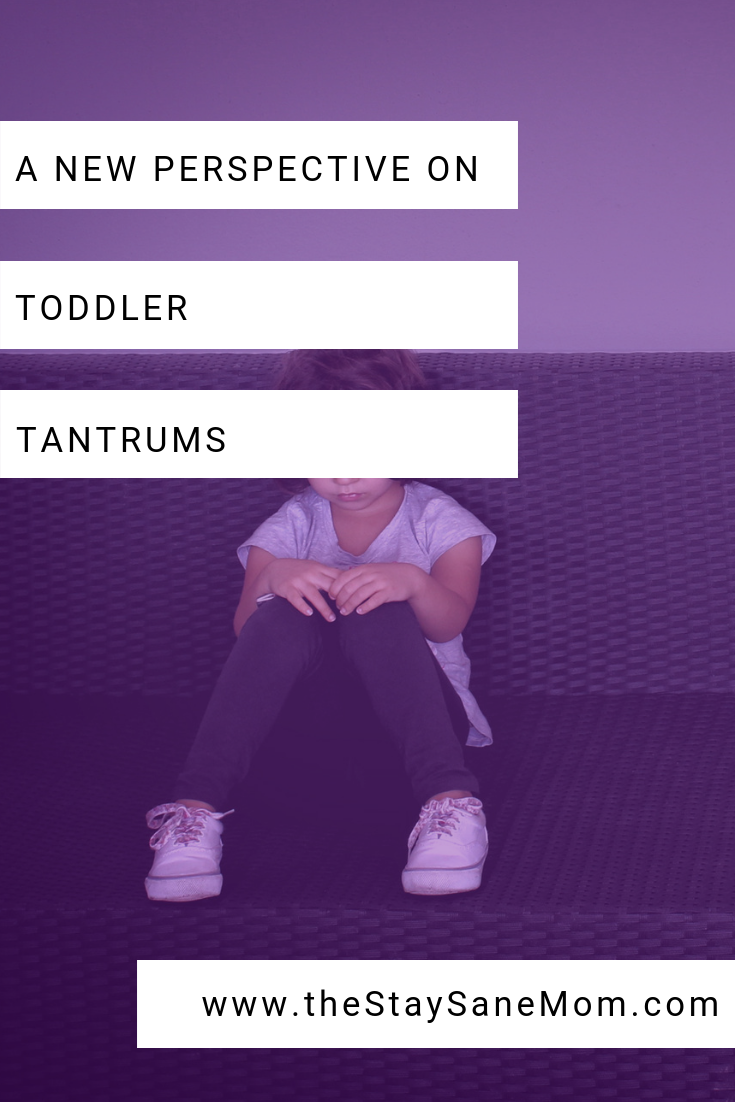How to Deal With Tantrums

How to Deal With Tantrums
By understanding what's happening in a toddler's brain when they're throwing a tantrum, you can both help create future emotional stability and make the shrieking stop.
Written by Liz Bayardelle, PhD | See Comments | Updated 12/13/2018
Want to cut to the chase?
Tantrum Survival Playbook

How to Deal With Tantrums
This post contains some affiliate links for your convenience. Click here to read my full disclosure policy.
All toddler parents know the scenario I'm talking about. They've seen it in their nightmares. You're on a peaceful shopping trip. You're one pack of toilet paper and two boxes of poptarts away from escaping Target unscathed. And that's when it happens.
*cue Jaws theme song*
You carefully avoided the toy aisle (because you're not stupid) but you accidentally walk past an endcap filled with tantalizing, brightly-colored, toddler bait. Curse you Target, foiled again.
You watch almost as if in slow motion as your little one sees the forbidden toys. You fruitlessly try to steer the cart away as quickly as possible, screaming internally, but it's no use.
The tiny fists start to ball up. The face starts getting red. The tears are locked and loaded, on standby for when they're needed. Your little angel's blossoming verbal skills get thrown out the window as they start making gestures and caveman grunts at their shiny new obsession. You try and pacify them but you know in your heart it's already too late.
You're just another victim to the Target tantrum.
Why Kids Have Tantrums (Some Brief Evolution)
When you're in a good mood and a quiet room, you can probably rationally understand the basic logic behind a tantrum.
Your kid sees something they want (but can't have) and their poor little noggin doesn't understand how to deal with frustration, delayed gratification, or other complex adult coping mechanisms for disappointing situations. They can't handle it, so they break down.
If you think about the frustrations in your life and subtract the herculean amount of self-discipline, willpower, and control you've finely honed over the years, would your basic reaction be too different?
I'm a grown-ass woman, but if I'm sleep-deprived, hungry, and low on emotional reserve I am not above dropping a tear or two in the middle of a FedEx shipping center. (As I unfortunately demonstrated a few days ago...don't ask.)
When babies are born, they have all the basic bodily functions down pat. They can eat, get rid of what they eat (yay dirty diapers), sleep, keep their lungs working, and their hearts pumping, but that's about all. They have the basic mental capacity of a lizard. An adorable lizard, but still not too high up on the evolutionary chart.
As they grow, they progress from their lizard-like baby brains, up through the evolutionary chart, to the fully-functioning, world-dominating, buy-your-own-groceries-and-everything level of cognitive functioning you currently enjoy.
However, this is a process. In their toddler years, they're still somewhere around "monkey" in the evolutionary process. They understand the basics of good and bad (i.e. being quiet and polite good, yelling and screaming bad), but when there's a conflict between these higher concepts and their primal emotions it's the emotions which are going to win out every time.
The Parent's Role During a Tantrum
Great. So my child's basically a monkey right now. Cute metaphor, but not too helpful when they're doing their gremlin-after-midnight impression in aisle 17 of the grocery store.
Here's where a parent's actions can have a long-term effect on a child's behavior, emotional competence, and eventual mental stability.
Now, before we get into it, you might have noticed I said long-term effect. This means that over a period of time you can have a marked, positive effect on your child's behavior, emotional capabilities, and capacity to keep their freaking calm when in the immediate proximity of a toy they can't have.
Unfortunately, there is no magical, child-whisperer, cure-all that will eliminate tantrums immediately. It just doesn't exist. Controlling your emotions (as we moms probably know better than anyone) is a learned skill, not an on-off switch. It takes, time and practice to improve emotional control, just like riding a bike or learning to speak.
So what can a parent do during a tantrum?
It is our job to help show our little screaming munchkin how to control their emotions.
Notice I said show, not tell. No one in the history of the world has ever calmed down because someone said to calm down. We have to show them the way we would show them how to ride a bike. Step by step, making small corrections and relying largely on modeling.
Now, I go over some strategies for doing this in the attached "Tantrum Survival Playbook" (the free PDF at the beginning or end of this post), but let's take a quick look at why exactly why this is so important AND why your reactions to the first few tantrums will determine how hard (or easy) your tantrum-life is going to be from here on out.
Neuropsychology and Sledding
Imagine you're the first person on the top of a sledding hill after a new snowfall.
You look down and there is nothing but fresh snow all the way down the hill. You take that first sled ride down the hill (wheeeee) and then walk up the side of the hill to go again. Now instead of a fresh coat of snow, there's a pathway there. Unless you intentionally try to take a different path down the hill, your sled is going to take the same path as before simply because, being already worn, it will be the path of least resistance. With each subsequent run down the hill (wheeee again), the trench made by your sled will get deeper and more worn, making it harder and harder for your sled to take a different track.
If you do want to change the pathway down the hill after a few runs, it might take a lot more work than it previously would have had you tried to change after the first or second run.
Now let's bring this metaphor back to the little creature currently garnering dirty looks due to their anguished sobbing.
[The following is a tremendously oversimplified explanation of the neuropsychology concept of "neuroplasticity". I find this to be one of the most fascinating things about the human body, so please do read more on it if you have nerdy inclinations. You won't regret it.]
The human brain is born with an incredible ability to adapt. Much like your muscles, which grow when used and atrophy when neglected, the pathways in the brain that are used frequently become stronger, more solidified, and bigger. The pathways which are less frequently used eventually lose their neurological "real estate" to the parts of the brain that are more frequently used. (Basically, there is only so much space in the brain, so we have evolved to reallocate neurological resources to the functions used most often, often taking them away from functions which are less used.)
Basically, the more we think in certain ways, the easier it becomes to think in that way again. Just like our imaginary sledding hill, whatever path we take the first few times is likely to be the path taken on subsequent runs.
For your toddler, this means that however their first few tantrums "play out" is most likely going to be how future tantrums are going to go. However, if you reroute your toddler's tantrum sled into more productive behaviors, you can help them practice methods of dealing with strong, unpleasant emotions that will help them far into adulthood.
So with that in mind, I want to quickly propose a five step "playbook" for dealing with your toddler's tantrums in a way that builds healthy, productive skills for how to deal with emotions that feel "too big".
I'll go over these steps briefly here but more is in the attached "Tantrum Survival Playbook", so definitely take a look.
5 Steps to Handling Toddler Tantrums
Step 1: Provide Physical Comfort
No matter how much you want to scream back at your kicking, biting munchkin, try to remember that --no matter what behavior they're displaying on the outside-- the tantrum is being caused by emotions that feel "too big" for your toddler to handle. This could be sadness, disappointment, anger, jealousy, or any number of other emotions. Having such strong emotions is hard, scary, and confusing for your little one, so try to remember that tantrums are about them being uncomfortable with emotion, not them being little hellions bent and determined to ruin your life. (No matter what it feels like.)
Once you've tried to reinforce the mindset that their tantrum isn't a personal vendetta against you, it's possible to react the same way you would to any other form of emotional distress. If your munchkin came up to you crying because they got hurt, you would immediately sweep them into a giant, loving hug. Now, even though that is often the last thing either of you seems to want in the middle of a tantrum, it is often exactly what they actually need.
I'm perpetually surprised by how often, if I offer a hug or snuggle in the middle of a tantrum, my toddler will immediately take me up on the offer. Not always, and don't force it if they don't want to be touched, but this is often an offer she'll snap up in a heartbeat. By soothing their emotional distress, you get rid of the panic that fuels the tantrum and begin allowing them to work towards a rational state of mind.
Step 2: Acknowledge the Underlying Need
Even though you might not plan to give them what they want (nor should you), try to acknowledge that they have a valid desire behind their tantrum. By putting a voice to what they're "saying" (i.e. "you must be really sleepy, huh buddy?" or "I see that you really wanted to play with that toy"), you're teaching them to understand what's going on in their confusing little world.
They aren't born with the ability to understand emotions and put their feelings into words, so by showing them how to translate their scary emotions into actual English, we're helping them on this important first step to actually handling them.
Also, when anyone is sad/stressed/angry, it helps to know that someone else understands what you're going through. By making them feel "heard", you put the two of you on the same team and let them know that you understand their needs.
Step 3: Guide Them Through Self-Soothing
Just as babies aren't born knowing how to put emotions into words, they aren't born knowing how to calm themselves down. Heck, I still have trouble doing it and I'm in my 30s. By helping them learn to take deep breaths, talk clearly, and stop crying/hitting/whatever-ing, you're showing them which behaviors are "appropriate" ways of handling big feelings.
Plus, remember the sledding hill. Every time they perform a self-soothing behavior it becomes that much easier for them to do the next time.
Step 4: Stand Your Ground but Propose a Logical Solution
Once they're relatively calm, try reasoning with them. Try thinking of this not as a negotiation, but as an opportunity to meet their underlying need without giving them everything they're tantrum-ing for. For example, if they want their sister's toy, it could be because they're bored. Once they've calmed down, they might respond eagerly to an offer of the special toy they don't get to play with very often.
Now, this one takes some practice and involves really reading your kid well. Even for the most practiced parent it can often reaggravate the tantrum and land you back in the red-faced wailing mode. Be patient and start again with step 1. If all else fails, distraction, food, and (strangely enough) playing with water (no idea why) are also pretty good ways to get out of tantrum mode, once the kid has self-soothed a little bit.
Step 5: Just Live Through It the Best You Can
Finally, just be merciful with yourself. Every mom has had a Target tantrum. It's a rite of passage not too terribly unlike hazing at a sorority. Just get through it. And don't give a rat's...let's say "tail" about what other people think. Your kid is more important than other people's opinions anyway.
Also, remember your sledding hill. Something about knowing I'm teaching my little screaming she-demon how to handle emotions in a productive and healthy way makes it less about "dear God stop crying right now or I will join you" and more about "here's a life skill we're apparently going to practice right here in the produce aisle".
May the Odds Be Ever In Your Favor
You can do it, mama. Tantrums are hard, but once you see them for what they are (opportunities for your little one to practice dealing with emotions that are "too big" for them at the moment) it becomes less personal and more of a teaching moment.
Remember your sledding hill and neuroplasticity. Each time you guide them into self-soothing or rational thought it will make it that much easier for them to do that again the next time. This means every time you handle a tantrum like a boss, it'll make the next one that much easier on you.
If you want some practical, step-by-step tips and examples of how to handle things once a tantrum hits, don't forget to print out the free Tantrum Survival Playbook below and let me know how it works in the comments!
Start Your Next Step
Tantrum Survival Playbook

Get Sanity, Delivered to Your Inbox.
Care to Share?




About the Author

Liz Bayardelle, PhD
Founder | Contributor
Liz (or Dr. Mommy, as her toddler started calling her after learning what a PhD was) is the happily sleep-deprived mom of a toddler (and professional raccoon noise impersonator), a sparkle-clad kidnado, a teenage stepdaughter, 200 cumulative pounds of dog, and herd of dustbunnies (if daily vacuuming doesn't occur). During nights and naptimes, she uses her PhD in business psychology as an author, speaker, and consultant. She also serves as an executive and principal for three companies, two of which she co-founded with her very patient (and equally exhausted) husband.





-Budget.jpg)